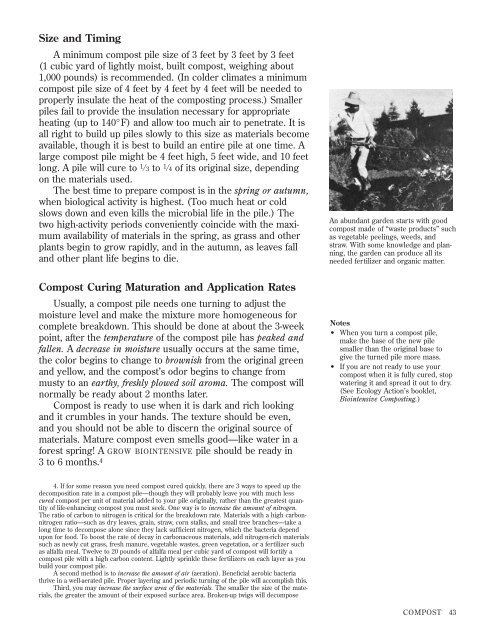How to Grow More Vegetables : And Fruits, Nuts ... - Shroomery
How to Grow More Vegetables : And Fruits, Nuts ... - Shroomery
How to Grow More Vegetables : And Fruits, Nuts ... - Shroomery
Create successful ePaper yourself
Turn your PDF publications into a flip-book with our unique Google optimized e-Paper software.
Size and Timing<br />
A minimum compost pile size of 3 feet by 3 feet by 3 feet<br />
(1 cubic yard of lightly moist, built compost, weighing about<br />
1,000 pounds) is recommended. (In colder climates a minimum<br />
compost pile size of 4 feet by 4 feet by 4 feet will be needed <strong>to</strong><br />
properly insulate the heat of the composting process.) Smaller<br />
piles fail <strong>to</strong> provide the insulation necessary for appropriate<br />
heating (up <strong>to</strong> 140°F) and allow <strong>to</strong>o much air <strong>to</strong> penetrate. It is<br />
all right <strong>to</strong> build up piles slowly <strong>to</strong> this size as materials become<br />
available, though it is best <strong>to</strong> build an entire pile at one time. A<br />
large compost pile might be 4 feet high, 5 feet wide, and 10 feet<br />
long. A pile will cure <strong>to</strong> 1 ⁄ 3 <strong>to</strong> 1 ⁄ 4 of its original size, depending<br />
on the materials used.<br />
The best time <strong>to</strong> prepare compost is in the spring or autumn,<br />
when biological activity is highest. (Too much heat or cold<br />
slows down and even kills the microbial life in the pile.) The<br />
two high-activity periods conveniently coincide with the maximum<br />
availability of materials in the spring, as grass and other<br />
plants begin <strong>to</strong> grow rapidly, and in the autumn, as leaves fall<br />
and other plant life begins <strong>to</strong> die.<br />
Compost Curing Maturation and Application Rates<br />
Usually, a compost pile needs one turning <strong>to</strong> adjust the<br />
moisture level and make the mixture more homogeneous for<br />
complete breakdown. This should be done at about the 3-week<br />
point, after the temperature of the compost pile has peaked and<br />
fallen. A decrease in moisture usually occurs at the same time,<br />
the color begins <strong>to</strong> change <strong>to</strong> brownish from the original green<br />
and yellow, and the compost’s odor begins <strong>to</strong> change from<br />
musty <strong>to</strong> an earthy, freshly plowed soil aroma. The compost will<br />
normally be ready about 2 months later.<br />
Compost is ready <strong>to</strong> use when it is dark and rich looking<br />
and it crumbles in your hands. The texture should be even,<br />
and you should not be able <strong>to</strong> discern the original source of<br />
materials. Mature compost even smells good—like water in a<br />
forest spring! A GROW BIOINTENSIVE pile should be ready in<br />
3 <strong>to</strong> 6 months. 4<br />
4. If for some reason you need compost cured quickly, there are 3 ways <strong>to</strong> speed up the<br />
decomposition rate in a compost pile—though they will probably leave you with much less<br />
cured compost per unit of material added <strong>to</strong> your pile originally, rather than the greatest quantity<br />
of life-enhancing compost you must seek. One way is <strong>to</strong> increase the amount of nitrogen.<br />
The ratio of carbon <strong>to</strong> nitrogen is critical for the breakdown rate. Materials with a high carbonnitrogen<br />
ratio—such as dry leaves, grain, straw, corn stalks, and small tree branches—take a<br />
long time <strong>to</strong> decompose alone since they lack sufficient nitrogen, which the bacteria depend<br />
upon for food. To boost the rate of decay in carbonaceous materials, add nitrogen-rich materials<br />
such as newly cut grass, fresh manure, vegetable wastes, green vegetation, or a fertilizer such<br />
as alfalfa meal. Twelve <strong>to</strong> 20 pounds of alfalfa meal per cubic yard of compost will fortify a<br />
compost pile with a high carbon content. Lightly sprinkle these fertilizers on each layer as you<br />
build your compost pile.<br />
A second method is <strong>to</strong> increase the amount of air (aeration). Beneficial aerobic bacteria<br />
thrive in a well-aerated pile. Proper layering and periodic turning of the pile will accomplish this.<br />
Third, you may increase the surface area of the materials. The smaller the size of the materials,<br />
the greater the amount of their exposed surface area. Broken-up twigs will decompose<br />
An abundant garden starts with good<br />
compost made of “waste products” such<br />
as vegetable peelings, weeds, and<br />
straw. With some knowledge and planning,<br />
the garden can produce all its<br />
needed fertilizer and organic matter.<br />
Notes<br />
• When you turn a compost pile,<br />
make the base of the new pile<br />
smaller than the original base <strong>to</strong><br />
give the turned pile more mass.<br />
• If you are not ready <strong>to</strong> use your<br />
compost when it is fully cured, s<strong>to</strong>p<br />
watering it and spread it out <strong>to</strong> dry.<br />
(See Ecology Action’s booklet,<br />
Biointensive Composting.)<br />
COMPOST 43












